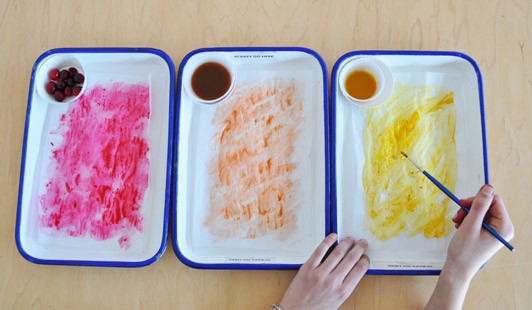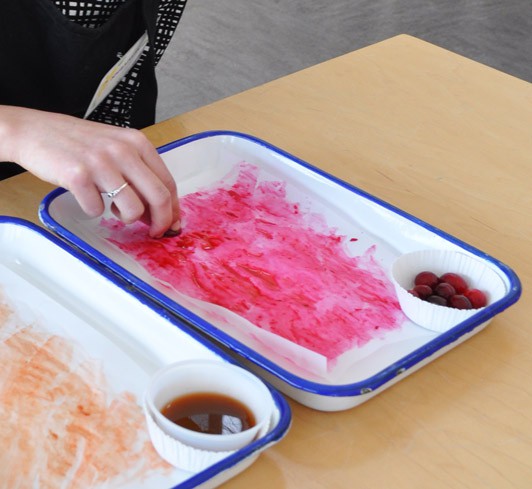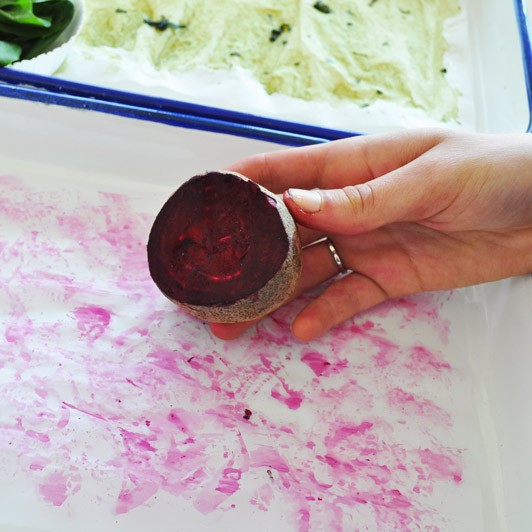Staining Paper with Natural Dyes
If you’ve ever spilled cranberry juice on your shirt, or tried scrubbing grass stains out of your jeans, then you know that natural dyes can leave a lasting, colorful mark on surfaces. Recently we used natural dyes to our advantage to stain papers for a new window display in the Art Studio. Studio Assistant Rebekah Buettner and Intern Shannon Dover (pictured above) helped me with gathering and experimenting materials for each “color” on the color wheel. Our favorite sources were: beets, frozen blueberries, dandelion greens, turmeric spice, fresh carrot juice, frozen cranberries, coffee grounds, and black charcoal. Keep reading to see our process!


For the “warm” colors of the wheel: red (previously frozen cranberries), orange (pure carrot juice), and yellow (watered down turmeric spice), Shannon painted the dyes onto sheets of plain tracing paper and used her bare hands to transfer the pigments to the paper. She did temporarily stain the skin on her hands, so if this bothers, you we recommend wearing gloves while you work with these materials.

For Yellow, we watered down the turmeric powder in a small container and brushed it directly on the paper. When it dried, you could feel the small granuals of the spice, and the color stayed really vibrant!

To make orange, we sent a few carrots through a kitchen juicer to separate all the juice from the pulp. Don’t water down the juice! We brushed a few layers of the pure juice onto the paper so the color would really pop. Over time the dried orange color began to fade, and we noticed the color did not last as long as the other warm colors.

Previously frozen cranberries had lots of bright red juice and were easy to squeeze and dye on the paper. Just allow the frozen cranberries to thaw on the counter until they are squishy. They’re ready to use!

Next, for the “cool” colors: Blue-purple (previously frozen blueberries), red-purple (beet), and green (mashed dandelion greens). We were surprised when the mashed blueberry dye was actually more purple than blue! It was difficult for us to find a natural blue dye. If you found a way to make blue naturally, please leave us a comment below! We mashed the thawed blueberries by hand into the paper. We chose to leave the small flecks of blueberry skin on the paper, but if you didn’t want to do that, you could easily pick off the skins once the paper is totally dry.

For red-purple, we used the beet much like a stamp, slicing it in half to reveal the center. The juice transferred easily, and the beet texture made an interesting mark on the paper. If you would rather have a flat stain, you could probably add a small amount of hot water to cut pieces of beet and brush the stained water onto the paper instead.

For green, we purchased a bunch of dandelion greens from the local grocery store, since the grass outside wasn’t quite green enough preparing for this project! Shannon found that mashing the greens with a mortar and pestle helped loosen the dye from the leaves. She then took the mashed leaves and used them to brush the dye onto the paper.

As we did earlier with the turmeric powder, Shannon added a small amount of water to the coffee grounds to paint brown, and to the charcoal to make black.

This was a really fun experiment! What natural materials could you use to stain papers? Stay tuned to find out how we will be using these beautiful papers in window display for the Art Studio!
